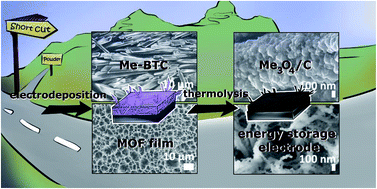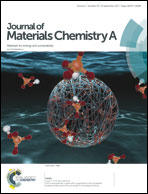Electrodeposited films to MOF-derived electrochemical energy storage electrodes: a concept of simplified additive-free electrode processing for self-standing, ready-to-use materials†
Abstract
The thermolysis of electrodeposited metal–organic framework (MOF) films represents a novel approach to build supercapacitor electrodes of already electrically contacted MOF-derived high-performance metal oxide/carbon materials which are also highly interesting for other applications. MOFs are widely utilised as precursors to synthesise functional materials by thermal decomposition (pyrolysis, carbonisation). Using electrochemically coated MOF precursor films instead of powder greatly simplifies the processing of such materials and potentially enhances the resulting active materials' performance. In the case of electrochemical energy storage electrodes, the coated substrate later functions as current collector which is well-attached to the active material without the need for any additives. This close connection decreases electron transfer resistances and saves multiple steps of powder formulation and coating. Films of a metal–organic framework based on 1,3,5-benzene-tricarboxylate (BTC) and cobalt(II) cations were electrochemically coated on cobalt foils which act as the Co2+ cation source. Manganese films were electrodeposited and subsequently partly redissolved in a linker-containing electrolyte to achieve Mn/Mn–BTC bilayered films on stainless steel. This procedure extends the method for any kind of current collector material. The films were thermolysed to gain nanostructured metal oxide spinel (Me3O4)/carbon hybrid electrodes. Investigations of the electrochemical properties in regard to supercapacitor applications show that Co3O4/C films exhibit pseudocapacitance and that Mn3O4/C films are suitable for redox electrodes with high-rate capability operating in a wide potential range in aqueous electrolytes. Co–BTC powder was also thermally treated yielding cobalt particles embedded in a graphitic carbon matrix. The pseudocapacitive properties of conventionally coated films of this powder material are limited.



 Please wait while we load your content...
Please wait while we load your content...